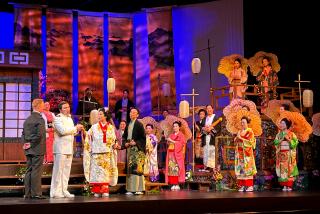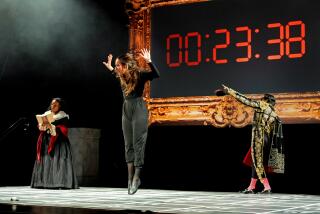Diversions : The Mighty Wurlitzer : ‘King of Instruments’ Renews Interest in Pipe Organs of the Silent Film Era
- Share via
Roosting in the maw of the velvet-covered console with a spotlight bathing his broad shoulders, organist Bill Field holds the audience at El Segundo’s Old Town Music Hall in the palm of his hand.
With a flick of a finger, a snap kick at the crescendo pedal and a laser-like jab at the combination pistons, Field performs a rousing rendition of “76 Trombones”--all glockenspiels, tubas and trumpets blaring as if the Music Man himself were leading the march down the center aisle of the theater.
And this is just the warm-up.
For the audience sing-along, Field’s fingers pour over the Wurlitzer’s four rows of keys like liquid silver, producing “Bill Bailey,” “My Gal Sal” and “Shine On Harvest Moon.”
Next, the lights of two gaudy chandeliers dim as a short silent film flickers on the screen--a cops-and-robbers romp brought to life by every siren, whistle and ah-HOO-gah horn in Field’s organ arsenal.
After another short, Field’s partner, Bill Coffman, cues up the silent epic, “Phantom of the Opera,” starring Lon Chaney.
For a quarter of a century, Field and Coffman have been reintroducing older patrons--and winning over new ones--to the mighty Wurlitzer. The pipe organ opened vaudeville acts, played intermissions and eventually replaced full symphony orchestras as the sound accompaniment for silent movies.
“Pipe organs were the soul and sound of the old theaters,” says Field, whose 1922 movie house offers a glimpse of an era when pipe organs were crowned the “King of Instruments.”
In theaters, civic auditoriums and private showrooms from Santa Catalina to San Bernardino, pipe organs are helping time travelers recapture the instrument’s golden age.
Between roughly 1910 and the United States’ entry into World War I, vaudeville theaters were modified and embellished to accommodate the screening of silent moving pictures. Steadily, these houses evolved into larger-than-life showcases with enticements for not only the rich but also the impoverished.
“For a brief period of your life,” says Don Manning of Los Angeles Conservancy, “you could leave behind your humble existence and live like royalty.”
After World War I, promoters and impresarios like Sam (Roxy) Rothapfel stocked their palaces, each grander than the one before, with fish-laden fountains, galleries of oil paintings, arcades of mirrors, squads of uniformed ushers, resident orchestras and all the marble, terrazzo tile and terra cotta their investors could afford.
Central to the stagecraft of these grand temples was the organ, which could imitate all the instruments of the orchestra. Many profit-minded cinema owners who could not afford to keep a full symphony orchestra in the pit all day quickly discovered that these “one-man bands” could supplant the 30 or 40 musicians needed to accompany a silent movie.
Unlike the classical church organ, this popular musical marvel also came equipped with a full complement of percussion instruments and special effects that could duplicate the sound of swishing surf, pelting rain or smashing crockery.
“It had sounds like machine guns, train whistles and ah-HOO-gah horns that you’d never find at the First Congregational Church,” says Allen Mitchell, stage manager of the California Theater in San Bernardino, which houses a Wurlitzer.
Ironically, both Robert Hope-Jones, the creator of the Unit Orchestra pipe organ, and Rudolph Wurlitzer, who manufactured Hope-Jones’s invention, died in 1914 on the eve of Hollywood’s great silent film era.
Of course, there were several other manufacturers of theater organs--Kimball, Moller, Page, Barton or Robert Morton of Van Nuys--but to the average theatergoer, if the organ rose out of the depths of the orchestra pit, releasing a tremulous and thunderous roar, it had to be a Wurlitzer.
Gene Davis, 70, one of the Orpheum Theater’s regularly spellbound customers in the 1930s, says the Wurlitzer’s effect was often felt before it was ever heard.
“I remember coming down here with a girlfriend,” says Davis, “when the damn thing starts rumbling away. There were no lights, no nothing. Then the organist turns on the lights, plays three or four songs, walks up the aisle and disappears. I never forgot that,” said Davis, who helps maintain the same organ as a member of Los Angeles Theater Organ Society.
To Gaylord Carter, 86, who served as personal organist for silent comic star Harold Lloyd, the theater organ gave expression to a thousand emotions. When Lloyd was hanging on to the hands of the clock in the famous scene from the film “The Freshman,” Carter was apt to play “Time on My Hands” to entertain the audience.
In the madcap years of the silent films--roughly between Prohibition and the Great Depression--about 7,000 theater organs were built.
Then, with advent of the talkies in the late 1920s, a hush fell over the theater organ factories, and organists, who once put orchestra musicians out of work, were themselves seeking employment as studio musicians for radio or motion-picture companies.
During World War II, many of the grand theater organs were melted down and used for bombs and bullets.
Of those that survived, many turned up in churches, pizza parlors and funeral homes. Fortunately, the memories of the “hats, spats and cravats” generation survived as well, and many Wurlitzer worshipers lead restoration projects and theater-organ concerts.
Every Saturday morning since 1979, Gene Davis, crew chief Bob Bush and a cadre of volunteers have clambered up ladders, balanced on catwalks and worked in dark and dank pipe chambers at the Orpheum to check and repair the house organ.
Asked to explain the insanity of men in their 60s and 70s working in the dark, Davis says: “I defy you to find any other instrument that can perform like a Wurlitzer.”
More to Read
The biggest entertainment stories
Get our big stories about Hollywood, film, television, music, arts, culture and more right in your inbox as soon as they publish.
You may occasionally receive promotional content from the Los Angeles Times.










